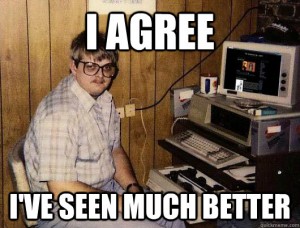
Years ago, before the advent of gigahertz processors, I used to draw a timeline for customers upgrading their computers. I caught myself doing the same thing last week for a customer who was replacing her ten year old laptop. She paid over $1,000.00 for her Windows XP machine and I was illustrating why a $300.00 laptop wasn’t a good replacement.
With each iteration of Windows operating system comes increased hardware requirements. Adding software into the mix adds to the requirements. Those who haven’t replaced their computer in several years are apt to compare new system specs to their old clunker which isn’t a valid comparison.
My diagram lines up the operating systems with memory and processor requirements. For example, Windows XP runs best with a minimum of 512MB of RAM and a single-core processor. In contrast, Windows 8 runs best on a quad-core processor and 6GB of memory. Throughout Windows generations, the requirements have increased incrementally.
Even though a $300.00 computer from a major department store comes with Windows 8 it doesn’t necessarily mean it will be a pleasurable experience. We see customers make this mistake all the time. Yes, the specifications of the cheapo computer are better than the one it’s replacing but those numbers aren’t truly representative of the functionality.
More important than all the numbers manufacturers advertise is user experience. I call this relative speed. In other words, it’s the speed or performance the user perceives when actually using the computer. I take into account how fast Windows starts, how applications perform and if the computer can easily multitask.
A top-of-the-line computer from ten years ago would have come with Windows XP. More than likely it would have had a dual core processor and 1GB of memory. In addition it would have likely been equipped with very good graphics capabilities. With regards to strictly technology, this computer would more than likely be able to handle many of today’s business applications.
In contrast to the best, let’s look at the economy system from ten years ago. It too would have come with XP; however, $300.00 would have purchased a single-core processor and 256MB of RAM. It would have had to have been retired about five years ago due to its inability to work with even the most basic business software updates.
Spending more buys more, I think that’s pretty sane logic. The more that’s purchased today almost guarantees it will last longer barring the system doesn’t have any imminent failures. Simply put, the technology will last longer and will be able to function even with future software demands. Budget systems may last a few years at best.
Business owners love when I put things in terms of dollars and cents so I’m going to spell it out another way. I would expect a $1,000.00 computer to last seven or eight years and a $300.00 computer to last two. Both will cost about the same per year; however, the more expensive computer will actually cost less to own because the business won’t come to a halt when the old computer fails.
I love when people ask me to help pick out a computer. Even though I don’t make a dime showing them why I think spending more is better, I know they’ll make the right decision for themselves. Technology is one of those things that buying more gets more. Unless you have a strict budget like I do most of the time, spend a little more now to save a big headache later.
(Jeromy Patriquin is the President of Laptop & Computer Repair, Inc. located at 509 Main St. in Gardner. You can call him at (978) 919-8059 or visit www.LocalComputerWiz.com.)